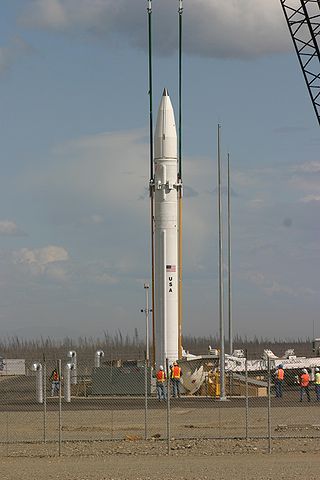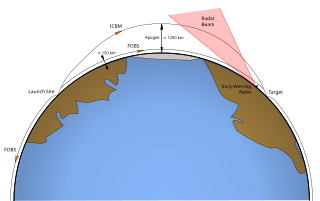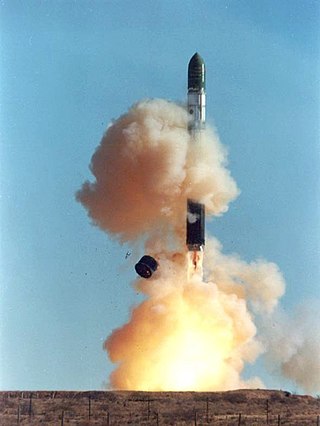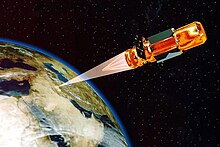
An anti-ballistic missile (ABM) is a surface-to-air missile designed to counter ballistic missiles. Ballistic missiles are used to deliver nuclear, chemical, biological, or conventional warheads in a ballistic flight trajectory. The term "anti-ballistic missile" is a generic term for a system designed to intercept and destroy any type of ballistic threat; however, it is commonly used for systems specifically designed to counter intercontinental ballistic missiles (ICBMs).

An intercontinental ballistic missile (ICBM) is a ballistic missile with a range greater than 5,500 kilometres (3,400 mi), primarily designed for nuclear weapons delivery. Conventional, chemical, and biological weapons can also be delivered with varying effectiveness, but have never been deployed on ICBMs. Most modern designs support multiple independently targetable reentry vehicle (MIRVs), allowing a single missile to carry several warheads, each of which can strike a different target. The United States, Russia, China, France, India, the United Kingdom, Israel, and North Korea are the only countries known to have operational ICBMs.

The Strategic Defense Initiative (SDI), nicknamed the Star Wars program, was a proposed missile defense system intended to protect the United States from attack by ballistic strategic nuclear weapons. The concept was announced on March 23, 1983, by President Ronald Reagan, a vocal critic of the doctrine of mutually assured destruction (MAD), which he described as a "suicide pact". Reagan called upon American scientists and engineers to develop a system that would render nuclear weapons obsolete. Elements of the program reemerged in 2019 with the Space Development Agency (SDA).

Anti-satellite weapons (ASAT) are space weapons designed to incapacitate or destroy satellites for strategic or tactical purposes. Although no ASAT system has yet been utilized in warfare, a few countries have successfully shot down their own satellites to demonstrate their ASAT capabilities in a show of force. ASATs have also been used to remove decommissioned satellites.

A Fractional Orbital Bombardment System (FOBS) is a warhead delivery system that uses a low Earth orbit towards its target destination. Just before reaching the target, it deorbits through a retrograde engine burn.
The Polyus spacecraft, also known as Polus, Skif-DM, GRAU index 17F19DM, was a prototype Soviet orbital weapons platform designed to destroy Strategic Defense Initiative satellites with a megawatt carbon-dioxide laser. It had a Functional Cargo Block derived from a TKS spacecraft to control its orbit and it could launch test targets to demonstrate the fire control system.

Space warfare is combat in which one or more belligerents are situated in outer space. The scope of space warfare therefore includes ground-to-space warfare, such as attacking satellites from the Earth; space-to-space warfare, such as satellites attacking satellites; and space-to-ground warfare, such as satellites attacking Earth-based targets. Space warfare in fiction is thus sub-genre and theme of science fiction, where it is portrayed with a range of realism and plausibility. In the real world, international treaties are in place that attempt to regulate conflicts in space and limit the installation of space weapon systems, especially nuclear weapons.

The R-36 is a family of intercontinental ballistic missiles (ICBMs) and space launch vehicles (Tsyklon) designed by the Soviet Union during the Cold War. The original R-36 was deployed under the GRAU index 8K67 and was given the NATO reporting name SS-9 Scarp. It was able to carry three warheads and was the first Soviet MRV missile. The later version, the R-36M, also known as RS20, was produced under the GRAU designations 15A14 and 15A18 and was given the NATO reporting name SS-18 Satan. This missile was viewed by certain United States analysts as giving the Soviet Union first strike advantage over the U.S., particularly because of its rapid silo-reload ability, very heavy throw weight and extremely large number of re-entry vehicles. Some versions of the R-36M were deployed with 10 warheads and up to 40 penetration aids and the missile's high throw-weight made it theoretically capable of carrying more warheads or penetration aids. Contemporary U.S. missiles, such as the Minuteman III, carried up to three warheads at most.

Missile defense is a system, weapon, or technology involved in the detection, tracking, interception, and also the destruction of attacking missiles. Conceived as a defense against nuclear-armed intercontinental ballistic missiles (ICBMs), its application has broadened to include shorter-ranged non-nuclear tactical and theater missiles.

Brilliant Pebbles was a ballistic missile defense (BMD) system proposed by Lowell Wood and Edward Teller of the Lawrence Livermore National Laboratory (LLNL) in 1987, near the end of the Cold War. The system would consist of thousands of small satellites, each with missiles similar to conventional heat seeking missiles, placed in low Earth orbit constellations so that hundreds would be above the Soviet Union at all times. If the Soviets launched its ICBM fleet, the pebbles would detect their rocket motors using infrared seekers and collide with them. Because the pebble strikes the ICBM before the latter could release its warheads, each pebble could destroy several warheads with one shot.
The Global Rocket 1 was a Fractional Orbital Bombardment System (FOBS) intercontinental ballistic missile (ICBM) developed but not deployed by the Soviet Union during the Cold War. The system also was given the NATO reporting name SS-X-10 Scrag, and carried a Soviet GRAU index of 8K713 (8К713).

The militarisation of space involves the placement and development of weaponry and military technology in outer space. The early exploration of space in the mid-20th century had, in part, a military motivation, as the United States and the Soviet Union used it as an opportunity to demonstrate ballistic-missile technology and other technologies having the potential for military application. Outer space has since been used as an operating location for military spacecraft such as imaging and communications satellites, and some ballistic missiles pass through outer space during their flight. As of 2018, known deployments of weapons stationed in space include only the Almaz space-station armament and pistols such as the TP-82 Cosmonaut survival pistol.
A kinetic bombardment or a kinetic orbital strike is the hypothetical act of attacking a planetary surface with an inert kinetic projectile from orbit, where the destructive power comes from the kinetic energy of the projectile impacting at very high speeds. The concept originated during the Cold War.
The UR-200 was an intercontinental ballistic missile (ICBM) developed by Vladimir Chelomey's OKB-52 in the Soviet Union. It was known during the Cold War by the NATO reporting name SS-10 Scrag and internally by the GRAU index 8K81. The design was authorized by the Decisions of the Central Committee of the CPSU of March 16 and August 1, 1961, and the draft project was finished in July 1962. It first flew on November 4, 1963, from the Baikonur Cosmodrome. The ninth and final flight was conducted on October 20, 1964.

Nuclear weapons delivery is the technology and systems used to place a nuclear weapon at the position of detonation, on or near its target. Several methods have been developed to carry out this task.

The ASM-135 ASAT is an air-launched anti-satellite multistage missile that was developed by Ling-Temco-Vought's LTV Aerospace division. The ASM-135 was carried exclusively by United States Air Force (USAF) F-15 Eagle fighter aircraft.
The RS-28 Sarmat, often colloquially referred to as Satan II by media outlets, is a three-stage Russian silo-based, liquid-fueled, HGV-capable and FOBS-capable super-heavy intercontinental ballistic missile (ICBM) produced by the Makeyev Rocket Design Bureau. It is intended to replace the Soviet R-36M ICBM in Russia's arsenal.
The RD-861 is a Soviet liquid propellant rocket engine burning UDMH and nitrogen tetroxide in a gas generator combustion cycle. It has a main combustion chamber, with four vernier nozzles fed by the gas generator output. It can be reignited a single time.

The Exoatmospheric Reentry-vehicle Interceptor Subsystem, or ERIS, program, was a component of the United States' Strategic Defense Initiative during the Cold War. The ERIS system was named after Eris, Greek goddess of strife. ERIS was a kinetic kill system, launched from a ground-based system, and impacting directly to destroy an incoming Intercontinental ballistic missile (ICBM) before the targeted ICBM re-entered the Earth's atmosphere.
Project BAMBI was a project as part of the United States national missile defense.















